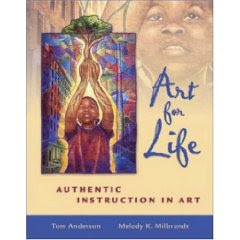Andrea Eisenberger and Joni Hough
October 6, 2009
ARTE 5121
ARTE 5121
Art/Integrated Lesson Plan: Life-Size Self-Portraits
Subject: Art & Language Arts
Grade Level: 3
NCSCOS Objective #: Art 1.06, 2.01, & 4.02; Language Arts 1.04
GOAL: The goal of this lesson is to explore language arts in the visual arts classroom by having students identify words that describe themselves and then juxtaposing those words with images to create a life-size self-portrait. This lesson gives students the opportunity to explore their identity and creative expression and helps them make the connection between what they see and what they think and/or feel.
DEVELOPMENTAL RATIONALE: At this age, students generally are becoming aware of the differences in people and can begin to understand what makes them unique. Students are also growing in critical skills, self-evaluation, and evaluation of others. This lesson will allow students to explore their emerging self-image. In the previous lesson in this unit, students created representational self-portraits using magic markers. Students studied facial proportions.
MATERIALS: Examples of self-portraits from
Picasso,

Kahlo,

Basquiat,

Lawrence,

and Liao;

butcher paper, pencils, markers, paint, brushes, magazine images, glue, pastels, chalk, decorative paper, scissors, computer with a variety of fonts, etc.
Websites for self-portrait examples:
Picasso: http://www.artchive.com/artchive/P/picasso/self7.jpg.html
Kahlo: http://www.paintinghere.com/UploadPic/Frida%20Kahlo/big/FridaKahlo-Self-Portrait-on-the-Border-Line-Between-Mexico-and-the-United-States-1932.jpg
Basquiat: http://rawartint.files.wordpress.com/2008/10/basquiat.jpg
Lawrence: http://culturemob.com/blog/wp-content/uploads/nationalacademyjacob-lawrence-self-portrait.jpg
Kathy Liao: http://www.kathyliao.com/
INTRODUCTION/MOTIVATION:
Day 1
1. Tell students to think of the things that make you what you are: (5 min.)
-the way you look
-the music you listen to and the music you make
-the words you write and the images you create
-what you've been through and how you feel now
-where you live and where you belong
-the things you love and the things you hate
-your family and friends
-the things that make you laugh and the things that make you cry
-the places you like and the places you fear
2. Have students write down five to seven words to describe who they are. (5 min.)
3. Show/discuss examples of self-portraits from Picasso, Kahlo, Basquiat, Lawrence, and Liao. (5 min.)
4. Have students describe artists based on their self-portraits. (3 min.)
VISUALIZATION/TRANSITION:
Day 1 (cont’d)
Tell students that we will now make our on life-sized self-portraits. Show students the example that the teacher made and explain that students will be making conceptual self-portraits. Encourage students to experiment with the shapes they can make with their outline. (2 min.)

ACTIVITY:
Day 1 (cont’d)
Divide students into same-sex pairs. (2 min.)
Have students take turns tracing each other’s outline on butcher paper. (15 min.)
Day 2
Have students fill in their outlines with a variety of media. (35 min.)
Students who complete this phase quickly may move on to the next phase.
Day 3
Have students print, affix, paint and/or collage their descriptive words onto their self-portrait using at least three different types of media. (25 min.)
Have students cut out their outlines. (10 min.)
SUMMARY/CLOSING: Students will show their finished self-portraits to the class and state what five to seven adjectives they used to describe themselves. Portraits will be displayed throughout the school.
EVALUATION/ASSESSMENT:
Did student use at least five words to describe him/herself?
Did student draw a life-size self-portrait?
Did student use three different media?
Did student incorporate text in self-portrait?
Did student use time wisely/participate in class?






No comments:
Post a Comment